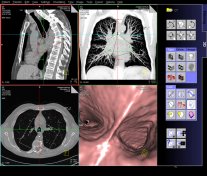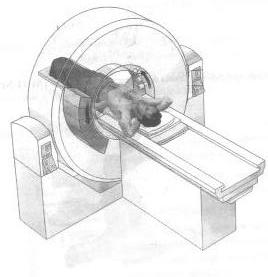CT Scan Services
Topics in this section include:
What is a CT Scan?
What does a CT involve?
How should I prepare?
What are the benefits vs. risks?
What is a CT Scan?
 CT imaging combines special x-ray equipment with sophisticated computers to produce multiple images or pictures of the inside of the body. With CT scanning, numerous x-ray beams and a set of electronic x-ray detectors rotate around you, measuring the amount of radiation being absorbed throughout your body. A special computer program processes this large volume of data to create two-dimensional cross-sectional images of your body, which are then displayed on a monitor.
CT imaging combines special x-ray equipment with sophisticated computers to produce multiple images or pictures of the inside of the body. With CT scanning, numerous x-ray beams and a set of electronic x-ray detectors rotate around you, measuring the amount of radiation being absorbed throughout your body. A special computer program processes this large volume of data to create two-dimensional cross-sectional images of your body, which are then displayed on a monitor.
For some CT exams, a contrast material is used to enhance visibility in the area of the body being studied.
What does a CT Scan involve?
 The technologist begins by positioning you on the CT examination table, usually lying flat on your back or possibly on your side or on your stomach.
The technologist begins by positioning you on the CT examination table, usually lying flat on your back or possibly on your side or on your stomach.
Depending on the type of examination you are having, a contrast material may be administered. The contrast material is used to enhance the images in certain types of CT scans. You will either swallow the contrast or it will be injected through an intravenous line (IV).
Next, the table will move quickly through the scanner to determine the correct starting position for the scans. Once positioned, the table will move slowly through the machine as the actual CT scanning is performed.
You may be asked to hold your breath during the scanning.
When the examination is completed, you will be asked to wait until the technologist verifies that the images are of high enough quality for accurate interpretation.
CT scanning of the body usually lasts between five and 30 minutes.
A radiologist will analyze the images and send a signed report to your primary care or referring physician, who will discuss the results with you.
How should I prepare?
Our scheduling department will assist in confirming your appointment and provide you with any preparation instructions you may need for your particular exam.
You should wear comfortable, loose-fitting clothing to your exam. You may be given a gown to wear during the procedure.
Metal objects including jewelry, eyeglasses, dentures and hairpins may affect the CT images and should be left at home or removed prior to your exam. You may also be asked to remove hearing aids or dentures.
You may be asked not to eat or drink anything for several hours before your appointment, especially if a contrast material will be used.
You should inform your physician of any medications you are taking and if you have any allergies. If you have a known allergy to contrast material your doctor may prescribe medications to reduce the risk of an allergic reaction.
Also inform your doctor of any recent illnesses or other medical conditions, and if you have a history of heart disease, asthma, diabetes, kidney disease or thyroid problems. Any of these conditions may increase the risk of an unusual adverse effect.
Women should always inform their physician and the CT technologist if there is any possibility that they are pregnant.
Exam Preparation:
Most CT scans do not require specific preparation, with the exception of CT scans of the Abdomen and Pelvis.
Abdomen and Pelvis
Please proceed to Rogue Valley Physicians Laboratory and Imaging Center for your oral prep kit at least one day before your scheduled appointment.
Oral prep instructions:
– Drink ONE bottle chilled the night before test.
– Drink ½ of second bottle 2 hours before the study, and remainder 1 hour before your appointment.
– No food for 6 hours before appointment.
– Drink lots of water.
NOTE: WITHOUT PROPER PREPARATION, WE WILL BE UNABLE TO PROCEED WITH YOUR EXAM.
What are the benefits vs. risks?
Benefits
- CT scanning is fast, painless, noninvasive and accurate.
- CT is able to image bone, soft tissue and blood vessels all at the same time.
- CT imaging provides real-time imaging, making it a good tool for guiding minimally invasive procedures such as needle biopsies and needle aspirations of many areas of the body, particularly the lungs, abdomen, pelvis and bones.
- A diagnosis determined by CT scanning may eliminate the need for exploratory surgery and surgical biopsy.
- No radiation remains in a patient’s body after a CT examination.
- X-rays used in CT scans usually have no side effects.
Risks
- There is always a slight chance of cancer from excessive exposure to radiation. However, the benefit of an accurate diagnosis far outweighs the risk.
- CT scanning is, in general, not recommended for pregnant women unless medically necessary because of potential risk to the baby.
- Nursing mothers should wait for 24 hours after contrast material injection before resuming breast-feeding.
- The risk of serious allergic reaction to contrast materials that contain iodine is extremely rare, and radiology departments are well-equipped to deal with them.
- Children should have a CT study only if it is essential for making a diagnosis and should not have repeated CT studies unless absolutely necessary.
Information regarding CT technology benefits and risks has been provided by www.radiologyinfo.org
